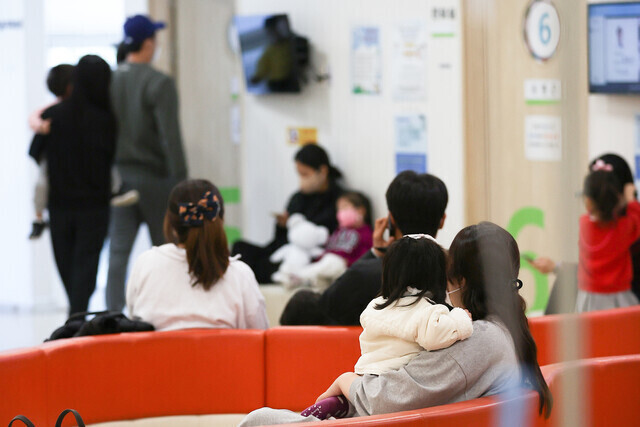hankyoreh
Links to other country sites 다른 나라 사이트 링크
Worse than worst case: Korea’s population is shrinking faster than predicted

Changes in South Korea’s demographic structure, including a low birth rate and aging society, are progressing at a rate far faster than previously predicted, statistics show.
An analysis of Statistics Korea’s future population trend figures over the years showed that the decline in South Korea’s population has grown steeper with time, at rates that frequently exceeded government predictions.
An example of this came in 2011, when Statistics Korea published a report on population trends for 2010–2060 that projected a 2023 total fertility rate (the number of children that a woman is expected to bear over her lifetime) of 1.37. Even its most pessimistic scenario gave a total fertility rate of 1.00 for this year.
But recent projections shared by Statistics Korea predicted a total fertility rate of 0.72 for 2023. That’s 0.28 fewer than even the least optimistic outlook as of 2011. This shows that the decline in birth rates is occurring much faster than previously anticipated.
Korea is expected to see around 230,000 births this year, only barely over half the 449,000 forecast in 2011. The lower threshold of births for 2023 predicted by the statistics agency in 2011 in its most pessimistic forecast was 317,000, but even this has proven high.
At the same time, the proportion of Koreans aged 65 and older out of the population this year hit 18.2%, only 0.1 points higher than the figure predicted in 2011.
There are concerns that if the trend of falling short of predictions continues, the degree of Korea’s population decline could far exceed forecasts. In its recently published population predictions for 2022-2072, Statistics Korea projected that Korea’s population could fall to 36.22 million by 2072, around a 30% drop from the total population as of 2022. The concern is that this prediction, too, will prove overly optimistic.
Current estimates place Korea’s fertility rate for 2022-2072 at dead last among members of the Organisation for Co-operation and Development. By 2072, Korea is expected to be the only member of the OECD with a working-age population that makes up less than 50% of the total population, at 45.8%, while having the highest proportion of the population over the age of 65 among OECD members, at 47.7% — two designations that will be an albatross around its neck.
By Park Jong-o, staff reporter
Please direct questions or comments to [english@hani.co.kr]

Editorial・opinion
![[Column] Season 2 of special prosecutor probe may be coming to Korea soon [Column] Season 2 of special prosecutor probe may be coming to Korea soon](https://flexible.img.hani.co.kr/flexible/normal/500/300/imgdb/original/2024/0426/3317141030699447.jpg) [Column] Season 2 of special prosecutor probe may be coming to Korea soon
[Column] Season 2 of special prosecutor probe may be coming to Korea soon![[Column] Park Geun-hye déjà vu in Yoon Suk-yeol [Column] Park Geun-hye déjà vu in Yoon Suk-yeol](https://flexible.img.hani.co.kr/flexible/normal/500/300/imgdb/original/2024/0424/651713945113788.jpg) [Column] Park Geun-hye déjà vu in Yoon Suk-yeol
[Column] Park Geun-hye déjà vu in Yoon Suk-yeol- [Editorial] New weight of N. Korea’s nuclear threats makes dialogue all the more urgent
- [Guest essay] The real reason Korea’s new right wants to dub Rhee a founding father
- [Column] ‘Choson’: Is it time we start referring to N. Korea in its own terms?
- [Editorial] Japan’s rewriting of history with Korea has gone too far
- [Column] The president’s questionable capacity for dialogue
- [Column] Are chaebol firms just pizza pies for families to divvy up as they please?
- [Column] Has Korea, too, crossed the Rubicon on China?
- [Correspondent’s column] In Japan’s alliance with US, echoes of its past alliances with UK
Most viewed articles
- 1AI is catching up with humans at a ‘shocking’ rate
- 2Korea’s 1.3% growth in Q1 signals ‘textbook’ return to growth, says government
- 3No good, very bad game for Korea puts it out of Olympics for first time since 1988
- 4[Column] Park Geun-hye déjà vu in Yoon Suk-yeol
- 5[Column] Season 2 of special prosecutor probe may be coming to Korea soon
- 6Division commander ordered troops to enter raging flood waters before Marine died, survivor says
- 7Is Japan about to snatch control of Line messenger from Korea’s Naver?
- 8After election rout, Yoon’s left with 3 choices for dealing with the opposition
- 9Will NewJeans end up collateral damage in internal feud at K-pop juggernaut Hybe?
- 10Marriages nosedived 40% over last 10 years in Korea, a factor in low birth rate